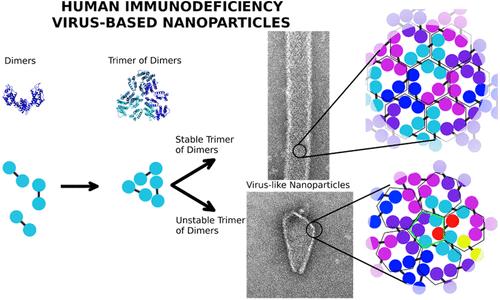导致不同人类免疫缺陷病毒类囊体纳米颗粒的另类自组装途径的结构基础
IF 15.8
1区 材料科学
Q1 CHEMISTRY, MULTIDISCIPLINARY
引用次数: 0
摘要
病毒粒子自发和忠实组装的机制正在指导着用于生物医学或纳米技术的基于蛋白质的自组装纳米结构的设计。本研究以人类免疫缺陷病毒(HIV-1)的噬菌体为模型,研究哪些分子特征可能决定具有预期结构的蛋白质纳米粒子而不是畸形粒子能否在体外自组装。我们曾尝试使用 HIV-1 包囊蛋白 CA 在体外实现锥形纳米粒子的自组装,这种粒子含有 CA 六聚体和五聚体,与真实的病毒包囊相似,但通常只产生六聚体管状粒子。我们假设,如果降低瞬时主要组装中间体--CA 二聚体的三聚体(ToD)--的稳定性,就会增加 CA 在体外组装成锥形颗粒而非管状颗粒的倾向。CA-CA界面上的某些氨基酸取代非常有利于体外组装成类似于真实HIV-1包囊的锥形纳米颗粒。全原子 MD 模拟表明,与 wt CA 或另一种组装成管状的突变体形成的 ToD 相比,更倾向于组装成锥形颗粒的 CA 突变体形成的 ToD 会破坏其稳定性。研究结果还表明,ToD的不稳定性是由不同CA-CA界面的构象畸变介导的,这种畸变消除了ToD内的一些蛋白质间相互作用。本文提出了一个模型,以合理解释 ToD 稳定性降低与粒子体外生长过程中 CA 五聚体形成倾向增加之间的联系,该模型有利于锥形 HIV-1 包囊状纳米粒子的组装。本文章由计算机程序翻译,如有差异,请以英文原文为准。

Structural Basis for Alternative Self-Assembly Pathways Leading to Different Human Immunodeficiency Virus Capsid-Like Nanoparticles
The mechanisms that underlie the spontaneous and faithful assembly of virus particles are guiding the design of self-assembling protein-based nanostructures for biomedical or nanotechnological uses. In this study, the human immunodeficiency virus (HIV-1) capsid was used as a model to investigate what molecular feature(s) may determine whether a protein nanoparticle with the intended architecture, instead of an aberrant particle, will be self-assembled in vitro. Attempts of using the HIV-1 capsid protein CA for achieving in vitro the self-assembly of cone-shaped nanoparticles that contain CA hexamers and pentamers, similar to authentic viral capsids, had typically yielded hexamer-only tubular particles. We hypothesized that a reduction in the stability of a transient major assembly intermediate, a trimer of CA dimers (ToD), will increase the propensity of CA to assemble in vitro into cone-shaped particles instead of tubes. Certain amino acid substitutions at CA-CA interfaces strongly favored in vitro the assembly of cone-shaped nanoparticles that resembled authentic HIV-1 capsids. All-atom MD simulations indicated that ToDs formed by CA mutants with increased propensity for assembly into cone-shaped particles are destabilized relative to ToDs formed by wt CA or by another mutant that assembles into tubes. The results also indicated that ToD destabilization is mediated by conformational distortion of different CA–CA interfaces, which removes some interprotein interactions within the ToD. A model is proposed to rationalize the linkage between reduced ToD stability and increased propensity for the formation of CA pentamers during particle growth in vitro, favoring the assembly of cone-shaped HIV-1 capsid-like nanoparticles.
求助全文
通过发布文献求助,成功后即可免费获取论文全文。
去求助
来源期刊

ACS Nano
工程技术-材料科学:综合
CiteScore
26.00
自引率
4.10%
发文量
1627
审稿时长
1.7 months
期刊介绍:
ACS Nano, published monthly, serves as an international forum for comprehensive articles on nanoscience and nanotechnology research at the intersections of chemistry, biology, materials science, physics, and engineering. The journal fosters communication among scientists in these communities, facilitating collaboration, new research opportunities, and advancements through discoveries. ACS Nano covers synthesis, assembly, characterization, theory, and simulation of nanostructures, nanobiotechnology, nanofabrication, methods and tools for nanoscience and nanotechnology, and self- and directed-assembly. Alongside original research articles, it offers thorough reviews, perspectives on cutting-edge research, and discussions envisioning the future of nanoscience and nanotechnology.
 求助内容:
求助内容: 应助结果提醒方式:
应助结果提醒方式:


